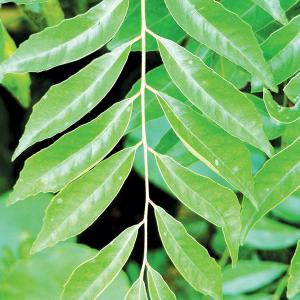Curry leaf doubles as houseplant, addition to healthy dishes
Tis the season of flavors and favors. Perhaps we even grovel or flatter at a holiday party so that we “curry favor.” Surprise - the curry of "curry favor" has nothing to do with Indian food, but comes to us from the French “conraier favel,” meaning to rub down a horse or donkey.
An ancient French story, “The Romance of Fauvel,” features a donkey named Fauvel. The name Fauvel itself is an acrostic made from the initial letters of the seven deadly sins in French: flaterie (flattery/pride), avarice (greed/gluttony), vilanie (wrath), variété (inconstancy), envie (envy) and lacheté (cowardice). The rich and powerful disgrace themselves by bowing down and stroking the coat of Fauvel, a donkey chosen as a false leader, thus “currying Fauvel.” Apparently nothing ingratiates you to a horse or donkey better than a good rubdown.
Just as currying favor has nothing to do with the Indian dish of curry, the houseplant curry leaf (Murraya koenigii) has nothing to do with curry powder. Commercial curry powder is a mix of spices such as cinnamon, turmeric and coriander that often does not even include true curry leaves.
Curry leaf is native to India and Sri Lanka and is a fast-growing bush or tree with deeply scented fernlike foliage. You can use the leaves in salads, chicken dishes, soups, flavored oils and even in teas.
In cooking, try adding the fresh leaves to hot oil to release the most flavor. Eat only the leaves. While the berries are safe, the seed they contain is poisonous if eaten. The leaves have a warm, delicious aroma and a faint, spicy flavor that goes well with chicken, lamb, beef, seafood and vegetable curries and pickles, as well as sweeter dishes such as chutneys, coconut sauces and marinades. Add finely chopped leaves to breads and baked goods for a surprisingly fresh taste.
South Asian traditional medicine uses curry leaf to treat the digestive system, skin conditions and especially diabetes. Researchers at King's College London believe that the Indian curry leaf may slow down the rate of starch-to-glucose breakdown, and the curry leaves could influence the amount of glucose entering the bloodstream.
Curry leaf plants are often found in Indian or Asian markets. Be sure you insist upon true curry leaves. Sometimes you will see an unrelated plant also called “curry plant” (Helichrysum italicum). You can also order the plants from online retailers such as Logee’s or Bhatia Nurseries.
This tropical plant does best indoors in full sun, where it will reach about one to three feet tall. Keep it away from draughts and above 55 degrees F. It blooms in summer with fragrant, small white flowers. Curry leaf plants like an acidic soil with a soil pH 5.6 to 6.0. Let soil become visibly dry between watering. This is where a clay pot is so much better than plastic because the clay lets the soil breathe and release excess moisture. Since they like humidity of 50 percent or higher, you can mist them, especially in hot, dry weather or in low humidity often found indoors during the winter. They also benefit from setting the pot above, but not touching, a tray of pebbles filled with water. As the water evaporates it releases humidity into the immediate area. You can propagate curry leaf from stem cuttings dipped in rooting hormone and planted in individual pots. These plants don't need a lot of food, so only give them a very weak fertilizer every month during spring and summer. Try a good liquid organic fertilizer at half strength. Do not feed them at all when growth is slow during the fall and winter.
For a refreshing, aromatic houseplant that doubles as a tasty addition to healthy dishes, grow an exotic curry leaf plant. You might even make up some curry leaf desserts to ingratiate you to your boss or lover, when you will truly curry favor.
















































